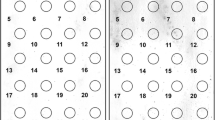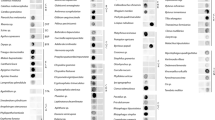Abstract
We studied the occurrence of the TTAGG telomere repeats by fluorescence in-situ hybridization (FISH) and Southern hybridization in ten insect species and two other arthropods. (TTAGG)n-containing telomeres were found in three Lepidoptera species, the silkworm Bombyx mori (in which the telomeric sequence was recently discovered), the flour moth Ephestia kuehniella, and the wax moth Galleria mellonella, in one species of Hymenoptera, the honey bee Apis mellifera, in one species of Coleoptera, the bark beetle Ips typographus, in one species of Orthoptera, the locust Locusta migratoria, and in a crustacean, the amphipod Gammarus pulex. They were absent in another species of Coleoptera, the mealworm Tenebrio molitor, two representatives of Diptera, Drosophila melanogaster and Megaselia scalaris, a species of Heteroptera, the bug Pyrrhocoris apterus and a spider, Tegenaria ferruginea. Our results, which confirm and extend earlier observations, suggest that (TTAGG)n was a phylogenetically ancestral telomere motif in the insect lineage but was lost independently in different groups, being replaced probably by other telomere motifs. In the Coleoptera this must have happened rather recently as even members of the same family, Curculionidae, differ with respect to the telomeric DNA.
Similar content being viewed by others
References
Beye M, Moritz RFA (1995) Characterization of honeybee (Apis mellifera L.) chromosomes using repetitive DNA probes and fluorescence in situ hybridization. J Hered 86: 145–150.
Biessmann H, Mason JM (1997) Telomere maintenance without telomerase. Chromosoma 106: 63–69.
Biessmann H, Mason JM, Ferry K et al. (1990) Addition of telomere-associated HeT DNA sequences ‘heals’ broken chromosome ends in Drosophila. Cell 61: 663–673.
Blackburn EH (1990) Telomeres and their synthesis. Science 249: 489–490.
Blackburn EH (1991) Structure and function of telomeres. Nature 350: 569–573.
Blin N, Stafford DW (1976) A general method for isolation of high molecular weight DNA from eukaryotes. Nucleic Acids Res 3: 2303–2308.
Cox AV, Bennett ST, Parokonny AS, Kenton A, Callimassia MA, Bennett MD (1993) Comparison of plant telomere locations using a PCR-generated synthetic probe. Ann Botany 72: 239–247.
Fuchs J, Brandes A, Schubert I (1995) Telomere sequence localization and karyotype evolution in higher plants. Plant Syst Evol 196: 227–241.
Glaser RW (1917) Cited in: Lokwood APM (1961) 'Ringer’ solutions and some notes on the physiological basis of their ionic composition. Comp Biochem Physiol 2: 241–289.
Greider CW (1996) Telomere length regulation. Annu Rev Biochem 65: 337–365.
Hiratsuka E (1969) The Family Tree of Japanese Silkworm Races (in Japanese). Tokyo: Institute of Sericultural Science.
Ijdo JW, Wells RA, Baldini A, Reeders ST (1991) Improved telomere detection using a telomere repeat probe (TTAGGG)n generated by PCR. Nucleic Acids Res 19: 4780.
Johnson DS, Mertl HG, Traut W (1988) Inheritance of cytogenetic and new genetic markers in Megaselia scalaris, a fly with an unusual sex mechanism. Genetica 77: 159–170.
Král J (1994) The Karyotype Analysis of Central European Spiders of Two Superfamilies, Amaurobioidea and Dictynoidea (Araneida). PhD thesis (in Czech, with English summary). Charles University, Prague.
Kristensen NP (1991) Phylogeny of extant hexapods. In: Naumann JD, Carne PB, Lawrence JF, eds. The Insects of Australia, Vol. 1, 2nd edition. Carlton, Victoria (Australia): Melbourne University Press, pp 125–140.
Kukalová-Peck J, Lawrence JF (1993) Evolution of the hind wing in Coleoptera. Can Entomol 125: 181–258.
Levis RW, Ganesan R, Houtchens K, Tolar LA, Sheen F-M (1993) Transposons in place of telomeric repeats at a Drosophila telomere. Cell 75: 1083–1093.
López CC, Nielsen L, Edström JE (1996) Terminal long tandem repeats in chromosomes from Chironomus pallidivittatus. Mol Cell Biol 16: 3285–3290.
Marec F (1990) Genetic control of pest Lepidoptera: Induction of sex-linked recessive lethal mutations in Ephestia kuehniella (Pyralidae). Acta Entomol Bohemoslov 87: 445–458.
Marec F, Traut W (1993) Synaptonemal complexes in female and male meiotic prophase of Ephestia kuehniella (Lepidoptera). Heredity 71: 394–404.
Meyne J, Ratliff RL, Moyzis RK (1989) Conservation of the human telomere sequence (TTAGGG)n among vertebrates. Proc Natl Acad Sci USA 86: 7049–7053.
Meyne J, Hirai H, Imai HT (1995) FISH analysis of the telomere sequences of bulldog ants (Myrmecia: Formicidae). Chromosoma 104: 14–18.
Moyzis RK, Buckingham JM, Cram LS et al. (1988) A highly conserved repetitive DNA sequence, (TTAGGG)n, present at the telomeres of human chromosomes. Proc Natl Acad Sci USA 85: 6622–6626.
Nielsen L, Edström J-E (1993) Complex telomere associated repeat units in members of the genus Chironomus evolve from sequences similar to simple telomeric repeats. Mol Cell Biol 13: 1583–1589.
Okazaki S, Tsuchida K, Maekawa H, Ishikawa H, Fujiwara H (1993) Identification of a pentanucleotide telomeric sequence, (TTAGG)n, in the silkworm Bombyx mori and in other insects. Mol Cell Biol 13: 1424–1432.
Orian AJE, Callan HG (1957) Chromosome numbers of gamma-rids. J Mar Biol Ass UK 36: 129–142.
Ostrjakowa-Warschawer WP (1937) Die grosse Wachsmotte Galleria mellonella L. als neues Object für genetische Untersuchungen. I. Einige Angaben über Biologie, Morphologie, Genetik und Züchtungsmethoden. (in Russia, German abstract). Biol Zh 6: 797–815.
Pelliccia F, Volpi EV, Lanza V, Gaddini L, Baldini A, Rocchi A (1994) Telomeric sequences of Asellus aquaticus (Crust. Isop.). Heredity 72: 78–80.
Petrunkewitsch A (1901) Die Richtungskörper und ihr Schicksal im befruchteten und unbefruchteten Bienenei. Jahrb Abt Allg Zool Physiol Tiere 14: 573–608.
Pich U, Fuchs J, Schubert I (1996) How do Alliaceae stabilize their chromosome ends in the absence of TTTAGGG sequences? Chromosome Res 4: 207–213.
Rasmussen SW (1977) The transformation of the synaptonemal complex into the ‘elimination chromatin’ in Bombyx mori oocytes. Chromosoma 60: 205–221.
Roth CW, Kobeski F, Walter MF, Biessmann H (1997) Chromosome end elongation by recombination in the mosquito Anopheles gambiae. Mol Cell Biol 17: 5176–5183.
Schulz HJ, Traut W (1979) The pachytene complement of the wildtype and a chromosome mutant strain of the flour moth, Ephestia kuehniella (Lepidoptera). Genetica 50: 61–66.
Socha R (1993) Pyrrhocoris apterus (Heteroptera) — an experimental model species: A review. Eur J Entomol 90: 241–286.
Stevens MN (1905) Studies in spermatogenesis, with special reference to the ‘accessory chromosome'. Carnegie Inst Wash Publ 36: 3–32.
Štys P, Zrzavý J (1994) Phylogeny and classification of extant Arthropoda: Review of hypotheses and nomenclature. Eur J Entomol 91: 257–275.
Tazima T (1964) Genetics of the Silkworm. London: Academic Press.
Traut W (1976) Pachytene mapping in the female silkworm, Bombyx mori L. (Lepidoptera). Chromosoma 58: 275–284.
Traut W (1977) A study of recombination, formation of chiasmata and synaptonemal complexes in female and male meiosis of Ephestia kuehniella (Lepidoptera). Genetica 47: 135–142.
Traut W, Sahara K, Otto TA, Marec F (1999) Molecular differentiation of sex chromosomes probed by genomic hybridization. Chromosoma 108: 173–180.
Virkki N (1960) Cytology of male meiosis in certain European forest beetles of the families Scolytidae, Cleridae, and Anobiidae. Ann Acad Sci Fennicae (Suomaliainen Tiedeakatemia, Helsinki) 49: 1–16.
Wang YX, Marec F, Traut W (1993) The synaptonemal complex complement of the wax moth, Galleria mellonella. Hereditas 118: 113–119.
White MJD (1973) Animal Cytology and Evolution, 3rd edn. Cambridge: Cambridge University Press.
Zakian VA (1995) Telomeres: Beginning to understand the end. Science 270: 1601–1607.
Zhang Y-J, Kamnert I, López CC, Cohn M, Edström J-E (1994) A family of complex tandem repeats in the telomeres of Chironomus pallidivittatus. Mol Cell Biol 14: 8028–8036.
Author information
Authors and Affiliations
Corresponding author
Rights and permissions
About this article
Cite this article
Sahara, K., Marec, F. & Traut, W. TTAGG Telomeric Repeats in Chromosomes of Some Insects and Other Arthropods. Chromosome Res 7, 449–460 (1999). https://doi.org/10.1023/A:1009297729547
Issue Date:
DOI: https://doi.org/10.1023/A:1009297729547




